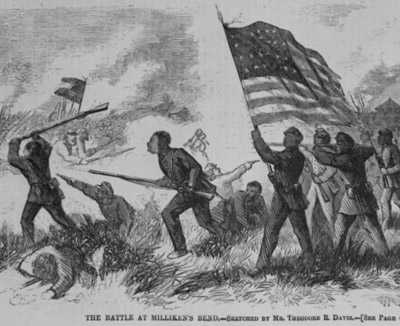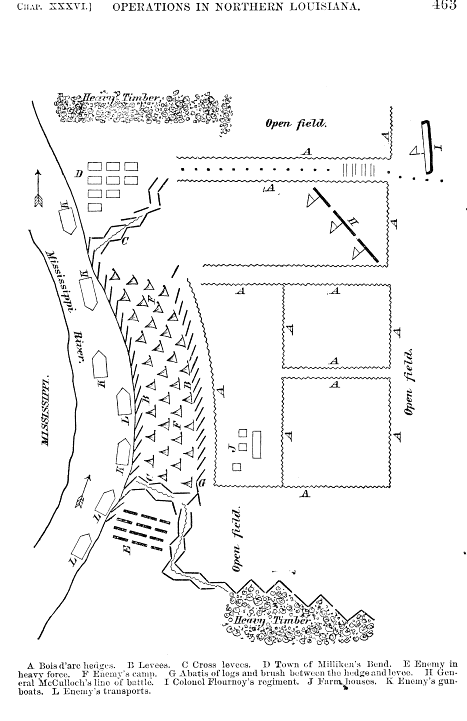
Known for his policy of confiscating slaves as contraband of war, one of the first steps in emancipation during the war, Butler made an even more audacious decision when in 1862, after his request for reinforcements for New Orleans was turned down, he allowed for the creation of the first all-Negro regiment of the Civil War: the 1st Louisiana Native Guards.
The Trans-Mississippi region would see more Negro soldiers fight than anywhere else in the Federal army. They would do some of the hardest fighting, especially in and around Fort Blakely in April 1865. Negro soldiers would earn the praise of their white comrades, starting in June 7, 1863 when they helped repulse a Confederate attack at Milliken’s Bend during Grant’s Vicksburg campaign. (Negro soldiers also saw action earlier at Pascagoula and Port Hudson.) This battle and the bravery displayed by the Negro troops probably helped to pave the way for more opportunities for them to fight.
The official battle summary of Milliken’s Bend goes like this:
On June 6, Col. Hermann Lieb with the African Brigade and two companies of the 10th Illinois Cavalry made a reconnaissance toward Richmond, Louisiana. About three miles from Richmond, Lieb encountered enemy troops at the Tallulah railroad depot and drove them back but then retired, fearing that many more Rebels might be near. While retiring, a squad of Union cavalry appeared, fleeing from a force of Rebels. Lieb got his men into battle line and helped disperse the pursuing enemy. He then retired to Milliken’s Bend and informed his superior by courier of his actions. The 23rd Iowa Infantry and two gunboats came to his assistance. Around 3:00 am on June 7, Rebels appeared in force and drove in the pickets. They continued their movement towards the Union left flank. The Federal forces fired some volleys that caused the Rebel line to pause momentarily, but the Texans soon pushed on to the levee where they received orders to charge. In spite of receiving more volleys, the Rebels came on, and hand-to-hand combat ensued. In this intense fighting, the Confederates succeeded in flanking the Union force and caused tremendous casualties with enfilade fire. The Union force fell bank to the river’s bank. About that time Union gunboats Choctaw and Lexington appeared and fired upon the Rebels. The Confederates continued firing and began extending their right to envelop the Federals but failed in their objective. Fighting continued until noon when the Confederates withdrew. The Union pursued, firing many volleys, and the gunboats pounded the Confederates as they retreated to Walnut Bayou.
Official Reports:
Report of Brig. Gen. Elias S. Dennis, U. S. Army, of attack, (7th) on Milliken’s Bend

For more reading: Milliken’s Bend – A Chapter in the Civil War